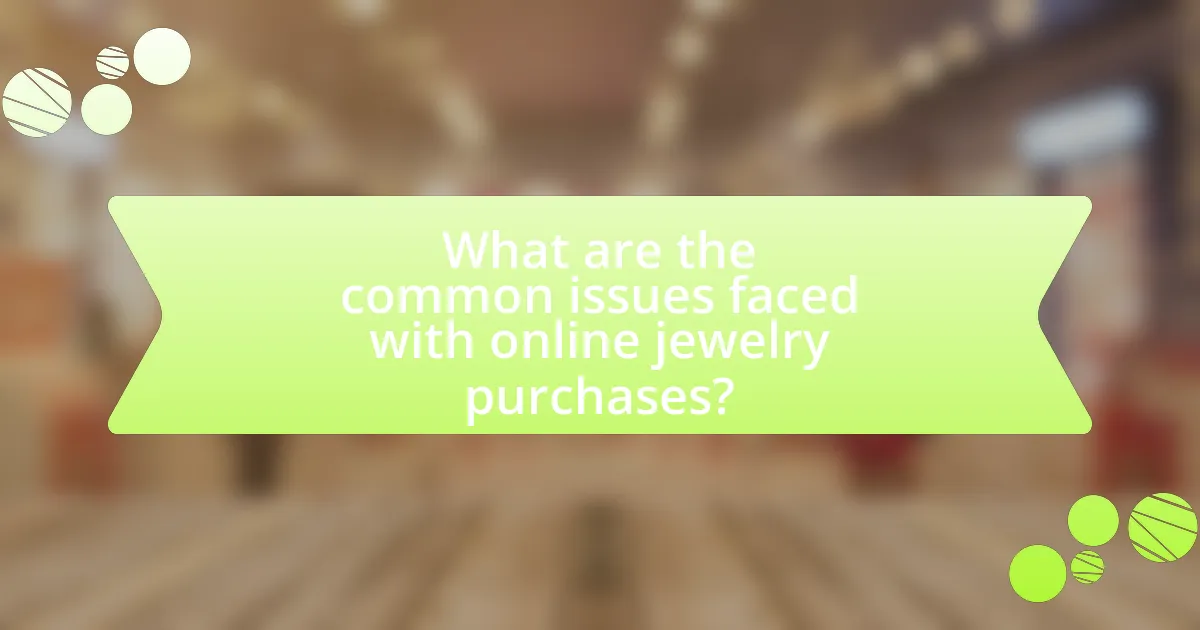The article focuses on the essential care practices for jewelry purchased online, emphasizing the importance of proper storage, cleaning, and maintenance to preserve its condition and longevity. Key topics include initial inspection upon receipt, methods for cleaning different materials, and precautions to take while wearing jewelry to prevent damage. Additionally, the article addresses common issues faced with online jewelry purchases, such as sizing inaccuracies and misrepresentation, and provides guidance on how to handle these challenges effectively. By following the outlined best practices, consumers can ensure their jewelry remains in optimal condition over time.

How should you care for your jewelry after buying online?
To care for your jewelry after buying online, store it in a dry, cool place, preferably in a soft pouch or a jewelry box to prevent scratches and tangling. Regularly clean your jewelry with a soft cloth to remove dirt and oils, and avoid exposing it to harsh chemicals or extreme temperatures, which can damage the materials. For specific types of jewelry, such as pearls or gemstones, use appropriate cleaning methods to maintain their luster and integrity. Proper care extends the lifespan of your jewelry and keeps it looking new.
What are the initial steps to take after receiving your jewelry?
After receiving your jewelry, the initial steps to take include inspecting the item for any damage, verifying the authenticity and quality, and cleaning it if necessary. Inspecting the jewelry ensures that any defects or issues are identified immediately, which is crucial for returns or exchanges. Verifying authenticity can involve checking for certificates or hallmarks that confirm the quality and value of the piece. Cleaning the jewelry, if needed, helps maintain its appearance and longevity, as dirt or oils can accumulate during shipping. These steps are essential for ensuring that your jewelry remains in optimal condition and meets your expectations.
How do you inspect your jewelry for any damage upon arrival?
To inspect your jewelry for any damage upon arrival, first examine the packaging for any signs of tampering or damage. Next, carefully remove the jewelry and visually inspect it for scratches, dents, or loose stones. Additionally, check the clasps and settings to ensure they are secure and functioning properly. This methodical approach helps identify any issues immediately, allowing for timely returns or exchanges if necessary.
What should you do if you find a defect in your jewelry?
If you find a defect in your jewelry, you should contact the retailer or manufacturer immediately to report the issue. Most reputable sellers have return or exchange policies that cover defective items, allowing you to receive a refund or replacement. According to consumer protection laws, you are entitled to a remedy for defective goods, which reinforces the importance of addressing the defect promptly.
Why is proper storage important for your jewelry?
Proper storage is crucial for jewelry because it prevents damage, tarnishing, and loss. Jewelry made from precious metals and gemstones can be easily scratched or tangled if not stored correctly. For instance, storing items in a soft-lined jewelry box or individual pouches minimizes exposure to air and moisture, which can lead to tarnishing. Additionally, keeping pieces separated reduces the risk of scratching and entanglement, preserving their condition and appearance over time.
What are the best practices for storing different types of jewelry?
The best practices for storing different types of jewelry include using individual compartments for each piece, keeping jewelry in a cool, dry place, and avoiding exposure to sunlight. Individual compartments prevent scratches and tangling, which is particularly important for delicate items like necklaces and bracelets. Storing jewelry in a cool, dry environment helps prevent tarnishing and damage, especially for silver and gold pieces. Additionally, avoiding sunlight protects gemstones from fading and losing their luster. These practices are supported by recommendations from jewelry care experts, emphasizing the importance of proper storage to maintain the quality and longevity of jewelry items.
How can you prevent tarnishing and scratching while storing jewelry?
To prevent tarnishing and scratching while storing jewelry, use anti-tarnish pouches or cloths and separate each piece to avoid contact. Anti-tarnish materials contain chemicals that inhibit oxidation, which is a primary cause of tarnishing. Additionally, storing jewelry in individual compartments or soft pouches minimizes friction and scratching between pieces. Research indicates that exposure to air and moisture accelerates tarnishing, so keeping jewelry in a dry, cool place further protects it.
How can you clean your jewelry effectively?
To clean your jewelry effectively, use a mixture of warm water and mild dish soap. Soak the jewelry for about 15-20 minutes, then gently scrub with a soft toothbrush to remove dirt and grime. Rinse the jewelry thoroughly under running water and dry it with a soft cloth. This method is safe for most types of jewelry, including gold and silver, and helps maintain their shine without causing damage.
What cleaning methods are safe for various materials?
Safe cleaning methods for various materials include using mild soap and water for gold and silver, a soft cloth for pearls, and specialized jewelry cleaners for gemstones. Gold and silver can be cleaned effectively with a mixture of warm water and a few drops of dish soap, ensuring no harsh chemicals are used that could damage the metal. Pearls require gentle cleaning with a damp, soft cloth to avoid scratching their surface, as they are sensitive to chemicals. For gemstones, it is advisable to use cleaners specifically designed for the type of stone, as some may be porous or sensitive to certain solutions. These methods are validated by jewelry care guidelines from reputable sources, such as the Gemological Institute of America, which emphasizes the importance of using appropriate cleaning techniques to maintain the integrity and appearance of jewelry.
How often should you clean your jewelry to maintain its shine?
You should clean your jewelry every few weeks to maintain its shine. Regular cleaning helps remove dirt, oils, and tarnish that can accumulate over time. For example, gold and silver jewelry can benefit from a gentle cleaning every two to four weeks, while gemstones may require less frequent cleaning depending on their exposure to wear and environmental factors. This routine not only preserves the jewelry’s appearance but also extends its lifespan by preventing buildup that can lead to damage.

What precautions should you take while wearing your jewelry?
While wearing your jewelry, you should avoid exposing it to harsh chemicals, moisture, and physical impacts. Chemicals found in cleaning products, perfumes, and lotions can damage the finish and integrity of the jewelry. Moisture from activities like swimming or showering can lead to tarnishing or corrosion, especially in metals like silver. Additionally, physical impacts from sports or manual labor can cause scratches or breakage. Taking these precautions helps maintain the jewelry’s appearance and longevity.
How can you protect your jewelry from everyday wear and tear?
To protect your jewelry from everyday wear and tear, store it in a soft-lined jewelry box or pouch to prevent scratches and tangling. This method minimizes exposure to dust and moisture, which can degrade materials over time. Additionally, remove jewelry before engaging in activities such as exercising, cleaning, or swimming, as these actions can cause physical damage or exposure to harsh chemicals. Regularly clean your jewelry with a soft cloth to maintain its shine and remove any buildup. According to the Gemological Institute of America, proper care can significantly extend the lifespan of jewelry, ensuring it remains in good condition for years.
What activities should you avoid to keep your jewelry safe?
To keep your jewelry safe, avoid activities such as swimming, exercising, and cleaning with harsh chemicals. Swimming exposes jewelry to chlorine and saltwater, which can damage metals and stones. Exercising can lead to scratches or loss if jewelry gets caught or falls off. Cleaning with harsh chemicals can corrode or tarnish jewelry materials. These activities can compromise the integrity and appearance of your jewelry, leading to potential damage or loss.
How does exposure to chemicals affect your jewelry?
Exposure to chemicals can significantly damage jewelry by causing tarnishing, discoloration, and degradation of materials. For instance, exposure to household cleaners, perfumes, and chlorine can lead to the corrosion of metals like silver and gold, resulting in a dull appearance. Additionally, chemicals can weaken gemstones, leading to cracks or loss of luster. Studies indicate that prolonged exposure to harsh chemicals can reduce the lifespan of jewelry, making proper care essential to maintain its appearance and integrity.
Why is it important to remove jewelry during certain activities?
It is important to remove jewelry during certain activities to prevent damage, injury, or loss. Engaging in physical activities, such as exercising or working with machinery, increases the risk of jewelry getting caught, leading to potential injuries or breakage. For instance, wearing rings while lifting weights can cause skin abrasions or even fractures if the ring gets stuck. Additionally, exposure to harsh chemicals, such as those found in cleaning products, can tarnish or corrode jewelry materials. Therefore, removing jewelry during these activities helps maintain its condition and ensures personal safety.
What specific activities pose the greatest risk to your jewelry?
Specific activities that pose the greatest risk to jewelry include exposure to harsh chemicals, physical activities that may cause damage, and improper storage. Harsh chemicals, such as those found in cleaning products, can tarnish or corrode metals and gemstones. Physical activities, like exercising or engaging in sports, increase the likelihood of scratching or losing jewelry. Improper storage, such as leaving jewelry in damp or cluttered areas, can lead to scratches, tangles, or even loss. These risks are well-documented in jewelry care guidelines, emphasizing the importance of proper handling and storage to maintain jewelry’s integrity.
How can you create a routine for removing jewelry at the right times?
To create a routine for removing jewelry at the right times, establish specific triggers or schedules that align with daily activities. For instance, remove rings before washing hands, take off necklaces before exercising, and store earrings before sleeping. This structured approach minimizes the risk of damage and loss, ensuring jewelry remains in good condition. Research indicates that consistent routines help in maintaining the longevity of jewelry, as regular exposure to water, sweat, and chemicals can lead to tarnishing and wear.

What are the common issues faced with online jewelry purchases?
Common issues faced with online jewelry purchases include misrepresentation of products, sizing inaccuracies, and quality concerns. Misrepresentation occurs when images or descriptions do not accurately reflect the actual item, leading to customer dissatisfaction. Sizing inaccuracies can result from a lack of standardized measurements, causing items to not fit as expected. Quality concerns often arise from the inability to physically inspect the jewelry before purchase, which can lead to receiving items that do not meet the buyer’s expectations in terms of craftsmanship or materials. According to a survey by the Better Business Bureau, 30% of online shoppers reported issues with product quality, highlighting the prevalence of these challenges in the online jewelry market.
How can you identify and address common problems with online jewelry?
To identify and address common problems with online jewelry, consumers should first examine product descriptions and customer reviews for accuracy and quality. Many issues arise from misrepresented items, such as incorrect sizing or material discrepancies. For instance, a study by the Better Business Bureau found that 30% of online jewelry complaints stem from items not matching their descriptions. To address these problems, buyers should verify return policies and ensure they can return or exchange items that do not meet expectations. Additionally, using reputable websites with secure payment options can mitigate risks associated with fraud or counterfeit products.
What should you do if your jewelry doesn’t match the online description?
If your jewelry doesn’t match the online description, you should contact the retailer immediately to report the discrepancy. Most reputable online jewelry stores have return policies that allow you to return or exchange items that do not meet the described specifications. According to the Federal Trade Commission, consumers have the right to receive products that match their descriptions, and retailers are obligated to honor their return policies. Therefore, documenting the differences with photos and keeping all correspondence can strengthen your case for a return or exchange.
How can you handle sizing issues with online jewelry purchases?
To handle sizing issues with online jewelry purchases, first, accurately measure your finger or wrist using a flexible measuring tape or a printable ring sizer available on many jewelry websites. This ensures that you select the correct size based on the specific sizing chart provided by the retailer, as sizes can vary between brands. Additionally, many online jewelers offer a return or exchange policy, allowing you to return or resize the item if it does not fit properly. According to a survey by the Jewelers of America, 30% of consumers reported sizing issues when purchasing jewelry online, highlighting the importance of precise measurements and understanding return policies.
What are the best practices for maintaining your jewelry’s condition?
To maintain your jewelry’s condition, regularly clean it with a soft cloth and store it in a dry, separate compartment to prevent scratches. Cleaning with a soft cloth removes dirt and oils that can dull the shine, while proper storage minimizes the risk of damage from contact with other pieces. Additionally, avoid exposing jewelry to harsh chemicals, such as those found in cleaning products, as they can cause tarnishing or degradation of materials. According to the Gemological Institute of America, proper care can significantly extend the life and appearance of jewelry, ensuring it remains in optimal condition for years.
How can you establish a regular maintenance routine for your jewelry?
To establish a regular maintenance routine for your jewelry, schedule periodic cleanings and inspections every six months. This routine ensures that dirt, oils, and tarnish are removed, which can prolong the life of the jewelry. Use a soft cloth for daily cleaning and a gentle jewelry cleaner for deeper cleans during inspections. Additionally, check for loose stones or signs of wear, as early detection can prevent costly repairs. Regular maintenance not only keeps jewelry looking its best but also helps maintain its value over time.
What tips can help prolong the life of your jewelry after online purchase?
To prolong the life of your jewelry after an online purchase, store it properly in a dry, cool place, ideally in a soft pouch or a jewelry box to prevent scratches and tangling. Regularly clean your jewelry with a soft cloth to remove dirt and oils, and avoid exposing it to harsh chemicals, such as those found in cleaning products or perfumes, which can damage the materials. Additionally, remove jewelry before engaging in activities that may cause physical stress, such as exercising or swimming, to prevent wear and tear. These practices are supported by jewelry care guidelines from experts, emphasizing that proper maintenance can significantly extend the lifespan of jewelry items.
